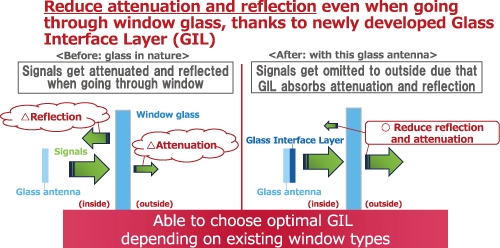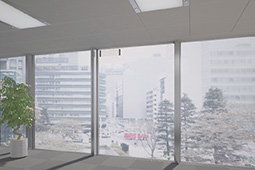Home > Highlighting JAPAN > Highlighting Japan October 2019 > Science & Technology
Highlighting JAPAN


An Unobtrusive Antenna
A new, transparent antenna has been developed that can be attached unobtrusively to a building’s windows rather than to its walls.
Base stations are essential for making calls, browsing the Internet and sending emails on a mobile phone. A base station is made up of an antenna and a wireless transceiver. More than 860,000 base stations of various sizes have been installed in Japan, on structures such as towers, buildings and electric utility poles. Through these base stations, mobile phone signals are sent and received.
In recent years, an increase in the use of mobile phones and other mobile radio communications, together with a large increase in data traffic, has made it necessary to establish stable, high-speed connections. NTT DOCOMO has increased the number of small cell base stations that create smaller service areas for places with a lot of traffic, and breaking up the traffic has led to improvements in service. But it is not so simple to increase the number of base stations within an urban area.
Akinobu Ueda, from the Radio Access Network Engineering Department at NTT DOCOMO, says, “It is difficult to get permission from building owners to install small cell base stations in the mid to lower floors of a building, as the base stations can spoil the scenery of an area. The same holds true for indoor installations. In addition to spoiling the interior design of a building, it’s difficult to create the ideal service area as attenuation occurs when signals pass through the building.”
To solve these problems, NTT DOCOMO entered into joint development with major glass manufacturer AGC, presenting a new glass antenna in November 2018. The antenna is 85 cm wide, 21.2 cm high and 6.6 mm thick, and on first glance appears to be normal transparent glass. However, the antenna becomes a base station when connected to cables and a wireless transceiver in the ceiling and attached to indoor window glass.
The antenna makes use of the laminated glass manufacturing technique used for the front windshield in cars. For laminated glass, resin is put between two sheets of regular glass and melted at high temperature, forming a single piece of glass. The glass antenna is made from the unified transparent resin and conductive materials that are placed between the two sheets of glass. In this way the glass becomes an antenna that can send and receive signals by conducting electricity.
Kentaro Oka, from AGC Building & Industrial Glass Company, says, “I don’t think the idea for using transparent conductive materials as an antenna existed before. The durability of the antenna was significantly increased by placing the conductive materials between glass.”
Moreover, a newly developed Glass Interface Layer (GIL) applied to the surface of the glass antenna reduces the signal attenuation and reflection that normally occurs when passing through window glass. The thickness of window glass varies according to window size and building floor height and normally affects the amount of signal attenuation and reflection, but by selecting the appropriate type of GIL, signals can be sent and received seamlessly no matter the size of the window glass the antenna is installed on.
Plans for commercialization of the glass antenna are now in the works and many inquiries have been received not just from Japanese mobile phone companies but also from companies overseas.
NTT DOCOMO and AGC are investigating the development of a glass antenna compatible with 5G, the next generation system of mobile communications. 5G will enable large amounts of data to be transmitted at very fast speeds, but the 5G signal has the disadvantage of being susceptible to attenuation from buildings, the atmosphere, rain and other obstacles.
Yukito Katsuyama, from the Radio Access Network Engineering Department at NTT DOCOMO, says, “Many base stations will be necessary if we move forward with implementing 5G. I think there will be an even greater need for glass antennas that can be installed without spoiling the scenery.”

© 2009 Cabinet Office, Government of Japan







